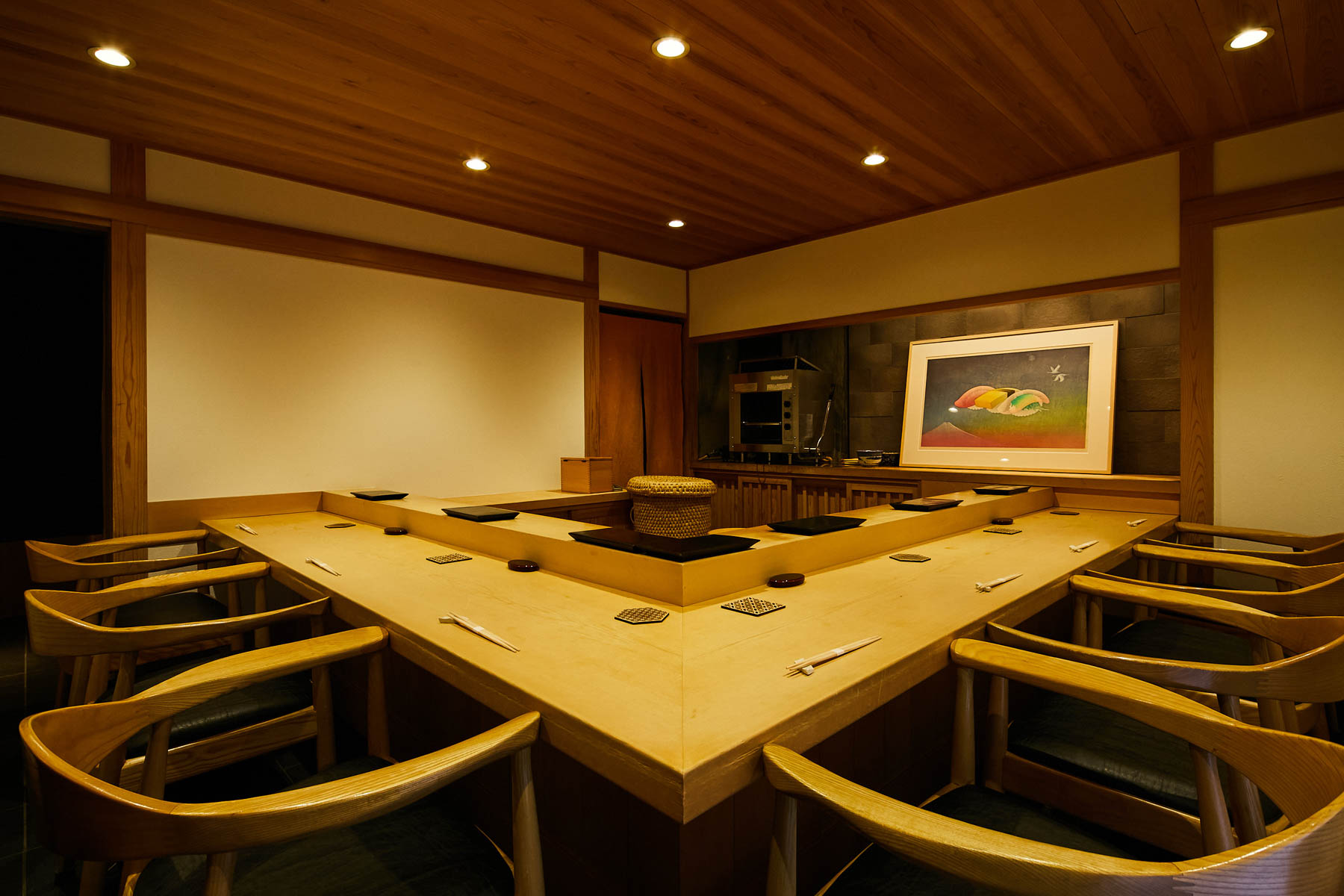
Tokyo
Sushi Miyuki
鮨 美幸
Sushi Miyuki shines as a beacon of an emerging sushi style in which an up-and-coming sushi artisan is given a stage to showcase their cuisine with the firm backing of a seasoned professional. Chef Konno is simultaneously a picture of youth and fortitude. The stunning sushi he serves and his inimitable hospitality leave no doubt as to why Sushi Hashimoto’s owner entrusted him with this space.
The Shintomi-cho neighborhood is close to Tsukiji and Ginza. Opened in June 2022 by Sushi Hashimoto owner Hiroyuki Hashimoto, the Sushi Miyuki interior remains predominantly the same in the location formerly occupied by Sushi Hashimoto, whose new location is just footsteps away. The original shop curtain still adorns the shopfront. The only addition is a woodblock print with a sushi motif, a celebratory opening gift from Hashimoto; the unique design incorporates three pieces of sushi, a crane – a symbol of longevity – and Mt. Fuji.
When Chef Konno and several others found themselves jobless with the pandemic-induced closure of Ginza Iwa, Chef Hashimoto generously brought all of them under his wing – an admirable move by a chef who not long ago went independent himself and was considered one of the young, rising stars of the genre. Throughout the most challenging times of the pandemic when restaurants could not operate normally, the current Sushi Miyuki was the kitchen for countless takeout serves of chirashi scattered sushi. Now it has been entrusted to Chef Konno.
Inside is a single L-shaped counter that can comfortably seat between six and eight guests. The counter and chopping boards are made from cypress from a log purchased fifteen years ago to build the counter in Chef Hashimoto’s father’s sushi restaurant in Koriyama, Fukushima. Homage to his parents can also be found in the name Sushi Miyuki, which takes one character each from their names, and even the design for the restaurant signage is based on Hashimoto’s mother’s brushstrokes.
CUISINE
A beacon of an emerging sushi style
In the chef’s omakase course, an octet of tsumami appetizers that speak of the season is followed by about eleven nigiri pieces, velvety egg, and a warming bowl of soup. The deceptively simple tsumami include marinated bonito from Kochi Prefecture, and a small bowl of vinegared rice topped with Hokkaido ikura salmon roe and a generous helping of flesh from Hyogo Prefecture seikogani female snow crabs pregnant with roe.
The chef’s exquisite knife skills are on display the moment the first nigiri arrives: kohada gizzard shad from Saga Prefecture treated with vinegar for a sharp pickled flavor. He then takes you on a journey through the lighter flavors of squid and sea bream before moving on to maguro akami, shellfish, shrimp, seasonal white-fleshed fish, chutoro, horse mackerel in concert with refreshing condiments, flame-grilled seafood, and gunkan submarine-shaped morsels.
The bluefin tuna, on this occasion, is a 130-kilogram fish caught by longline fishing off Shiogama, Miyagi Prefecture. The chef showcases the fish serving akami lean red flesh and buttery chutoro medium-fatty flesh. For the former, Chef Konno shapes the nigiri piece such that the sumptuous flesh wraps around the rice ovals. Kasugodai young red sea bream is both a harbinger and a picture of spring with cherry-blossom-colored skin. Brought into port at Oarai, Ibaraki Prefecture, Konno cures the fish with salt and kombu before service.
In all cases, the seafood is perched atop shari with distinct rice grains that release umami as you chew, and the ovals gradually unravel in your mouth. He alternates between condiments like ginger and green onions, a brush of a flavorful nikiri soy sauce reduction, or no toppings depending on the seafood item. He wishes that guests may enjoy the innate flavors of the ingredients, but he especially loves how the sushi artisan’s restrained touches can truly enhance an item. According to Konno, therein lies the intrigue of sushi as a cuisine.
INGREDIENTS
Daily visits to Toyosu Market ensure a steady supply of delicious seafood, including maguro from wholesalers Ishiji and Yunoka. Other items are shipped direct from suppliers at the source, like Fukuoka’s Fukuei Suisan. Konno uses the same rice as at Sushi Hashimoto: a blend of famous brands Hokkaido Nanatsuboshi, Yamagata Tsuyahime, and Fukushima Koshihikari. The wasabi comes from Gotemba, Shizuoka.


CHEF
Takashi Konno
TABLEWARE
Chef Konno adores tableware made by Dohei Fujinoki and his son, Yotaro, at their Dohei kiln in Karatsu, Saga Prefecture, for their unique and intriguing aesthetics. The staff of Sushi Hashimoto and Sushi Miyuki visited the kiln just before this restaurant opened, so it has a very special place in his heart. An integral element in the restaurant’s overall ambiance are works of the father – the rectangular ceramic pieces used as the serving plates for nigiri sushi. The round pieces, in contrast, are the work of the son. They carry delicious appetizers like steamed filefish liver to guests.
Course
- The price includes our booking fee of ¥8,000
- The price includes our booking fee of ¥8,000












